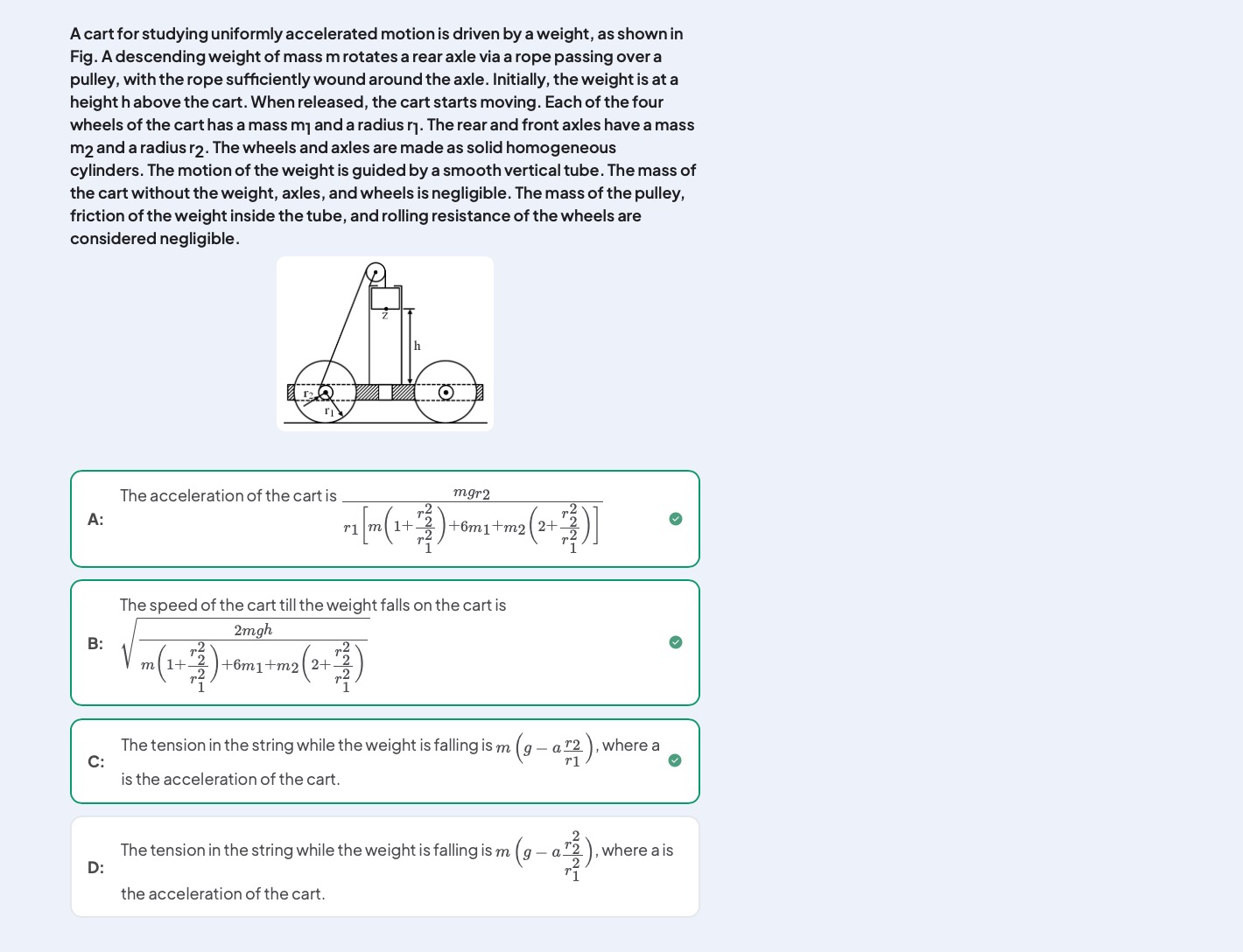Question
Question: A cart for studying uniformly accelerated motion is driven by a weight, as shown in Fig. A descendin...
A cart for studying uniformly accelerated motion is driven by a weight, as shown in Fig. A descending weight of mass m rotates a rear axle via a rope passing over a pulley, with the rope sufficiently wound around the axle. Initially, the weight is at a height h above the cart. When released, the cart starts moving. Each of the four wheels of the cart has a mass m₁ and a radius r₁. The rear and front axles have a mass m₂ and a radius r₂. The wheels and axles are made as solid homogeneous cylinders. The motion of the weight is guided by a smooth vertical tube. The mass of the cart without the weight, axles, and wheels is negligible. The mass of the pulley, friction of the weight inside the tube, and rolling resistance of the wheels are considered negligible.

The acceleration of the cart is r1[m(1+r12r22)+6m1+m2(2+r12r22)]mgr2
The speed of the cart till the weight falls on the cart is m(1+r12r22)+6m1+m2(2+r12r22)2mgh
The tension in the string while the weight is falling is m(g−ar1r2), where a is the acceleration of the cart.
The tension in the string while the weight is falling is m(g−ar12r22), where a is the acceleration of the cart.
A, B, and C are correct
Solution
Solution:
-
Effective Inertia of the Moving Parts:
- Each wheel (solid cylinder) of mass m1 and radius r1 has moment of inertia I=21m1r12. Rolling without slipping gives an effective inertia per wheel of m1+r12I=m1+21m1=23m1. For 4 wheels: total =4×23m1=6m1.
-
Axles and the Hanging Weight:
- Each axle is a solid cylinder of mass m2 and radius r2 (with moment of inertia 21m2r22). Their translation plus rotation give an effective contribution m2+r22I=m2+21m2=23m2 per axle. (Since there are two axles, their net contribution is written in a combined effective term found in the denominator as m2(2+r12r22) when the kinematic constraint of the rope (wound around an axle) is taken into account.)
- For the hanging weight m (whose rope is wound around the axle of radius r2), when the cart moves with acceleration a the rate at which rope is unwound relates by the ratio r1r2. Thus the weight’s equation of motion becomes mg−T=m(r1r2a). This immediately gives the tension as T=m(g−r1r2a). (This accords with option C.)
-
Acceleration and Speed:
- Writing down the net force on the whole system (with effective inertias of the hanging mass, the wheels, and the axles under the appropriate rope constraint) one obtains the acceleration a=r1[m(1+r12r22)+6m1+m2(2+r12r22)]mgr2. (This is exactly statement A.)
- Using energy conservation (loss of potential energy equals the total kinetic energy of translation plus rotation), the speed attained by the cart, when the weight has descended a height h, is v=m(1+r12r22)+6m1+m2(2+r12r22)2mgh. (This is statement B.)
-
Verification of Tension Expressions:
- We already obtained T=m(g−r1r2a), which is exactly option C.
- The alternative expression in D, T=m(g−ar12r22), does not follow from the kinematic constraint between the rope and the axle and is incorrect.
Thus, the correct statements are A, B, and C.
